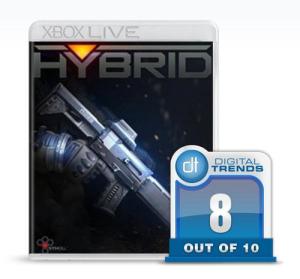 It takes a brave developer to build a game around the idea of turning a dirty word like “camper” into the operative word. Then again, this is 5th Cell we’re talking about, the same folks behind the wordplay of Scribblenauts. Xbox Live Summer of Arcade release Hybrid, the studio’s latest, couldn’t be further removed from the adorably cute puzzle-platforming of that earlier word game. Instead we have a slick, stylish third-person online shooter whose gameplay is built entirely around one core concept: cowering behind a wall. This isn’t a cover-based shooter; this is a cover-focused shooter.
It takes a brave developer to build a game around the idea of turning a dirty word like “camper” into the operative word. Then again, this is 5th Cell we’re talking about, the same folks behind the wordplay of Scribblenauts. Xbox Live Summer of Arcade release Hybrid, the studio’s latest, couldn’t be further removed from the adorably cute puzzle-platforming of that earlier word game. Instead we have a slick, stylish third-person online shooter whose gameplay is built entirely around one core concept: cowering behind a wall. This isn’t a cover-based shooter; this is a cover-focused shooter.
Hybrid‘s chief gimmick as a multiplayer shooter is that your movement around each map is constrained to left and right shuffles behind cover and quick jetpack bursts through the air as you move from one point to the next. You’re free to go wherever you like within that context, and you can also do things like change your course in mid-flight or retreat back to a previous position with nothing more than a button press. At the core though, the game’s 3v3 combat scenarios unfold with each squad trading fire from behind cover.
What’s surprising is how fast the action tends to move when, essentially, your primary strategy involves camping. There aren’t enough bodies on the ground with three-player teams to cover all of the angles on most maps, and so there’s a constant game of trying to flank while protecting your flanks. Kill streak unlocks also come very quickly, with players able to spawn different types of combat drones at one, three, and five kills, respectively, all of which amounts to the potential for a lot of lethal firepower concentrated in a single direction for each player.

The core gimmick works, but there are still a few rough edges. Hybrid ships with a fair number of maps, but they tend to feel largely the same due to the restrictions imposed by the unique gameplay rules. The environments might change, but the general layouts tend to mirror one another by necessity. The result is a shooter that doesn’t hold up over long play sessions. Hybrid is fun in bursts, but it’s not a game that most will be sitting down with for hours at a time.
It’s unfortunate, then, that there’s actually a well-developed meta-game and a level progression-based system of dangling carrots. Some items unlock at specific levels while others are unlocked as a category selection. So, for example, you might receive a Light Machine Gun token that you can then spend in the associated category on the weapon of your choice. It’s a neat approach to offering players more control over how they customize their character, though the selection of weapons and tools is ultimately rather limited. There’s also an unfortunate microtransaction element that allows you to skirt around progression-based unlocks in exchange for money.
Then you’ve got the meta-game, which is built around a worldwide war (minus Australia, oddly) between two warring factions. When you fire up the game for the first time, you’re asked to pick a faction without any real explanation as to what that means or what either one stands for. You’re offered an experience bonus for joining one or the other, likely 5th Cell’s tactic for balancing the overall numbers between the two factions.
As it turns out, there’s no real difference between the factions beyond the cosmetic. Regardless of which you choose, you’ll have access to the same weapons and the same level unlocks. On the gameplay side, the war between the two groups is charted in real time on a map of the world divided up into continents. Each continent is then further divided into smaller districts, and each one of those is where the battle for supremacy unfolds. You stand to earn XP bonuses for fighting in hotly contested territories, and there are additional bonuses as well for fighting in a specific district repeatedly and leveling up the base there. Again, it’s all very complex and poorly explained in the game, though 5th Cell has at least one video out there running through how things work.

Functionally, the game runs great at a nice 60fps clip. The only complaint I can level here is at the load times. There are a lot of them. Expect to wait an inordinate amount of time as the game searches the server for a lobby. In the matches I’ve played so far — team deathmatch is the star, but there are also some more objective-based options that seem to be less popular, based on the wait times — I’ve never landed in an in-progress game, so it looks like some of the delay could be related to the need to find a ready-to-play group. There’s also a decent wait once you’re in a lobby as the match loads. All of which ultimately plays out in a session that lasts only a handful of minutes. This, alongside the repetitive flavor of the map layouts, also hurts the value of lengthier play sessions.
Conclusion
Hybrid can be quite an entertaining game, but it’s definitely flawed in a number of ways. The cover-focused action works surprisingly well, and it amounts to a refreshing step in a different direection. The demands of the core gameplay gimmick unfortunately result in less moment-to-moment variety than you would typically encounter in a multiplayer shooter. And while the dangling carrot progression and meta-game elements are nice, they also feel out of place in a shooter that, for all of its focus on cover, hinges on twitch action and lightning-quick matches. Give 5th Cell credit for building a fun shooter around the dirty practice of camping, just don’t expect there to be much for you to invest in.
Score: 8 out of 10
(This game was reviewed on the Xbox 360 on a copy provided by Microsoft Studios)


